Welcome to the third of five posts revealing the latest OFR Top 50 Braves Prospects. This portion of the list is mostly full of players that combined strong improvement in 2018 with advancement. Due to the overall depth of the Braves farm system, many of these players would be potential top-10 prospects in many other systems. I have been joined in this segment by OFR colleague Andy Harris.
Also in this series:
Atlanta Braves Top 50 Prospects: #50-41
Atlanta Braves Top 50 Prospects: #40-31
Atlanta Braves Top 50 Prospects: #30-21
Atlanta Braves Top 50 Prospects: #1-10
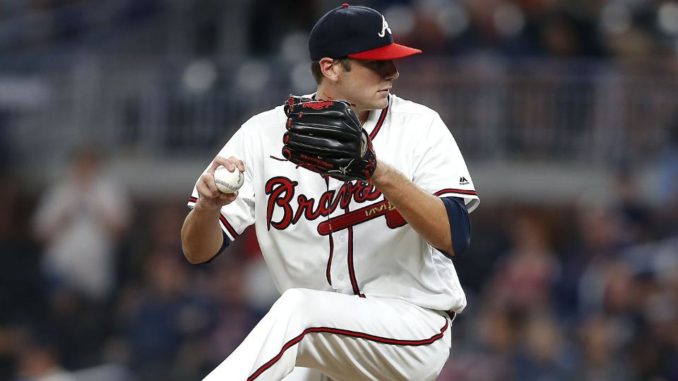
20. Chad Sobotka, RHP
Age: 25 | Throws: R
2.03 ERA | 2.67 FIP | 44 G, 1 GS | 57.2 IP | 4.53 BB/9 | 12.02 K/9 (A+, AA, AAA)
Current Assignment: MLB – Atlanta Braves
Acquired: Drafted, 4th Round – 2014
Prior Year Ranking: N/A
Chad Sobotka had perhaps the biggest rise of anyone in the Atlanta Braves organization this season. He started at advanced-A Florida, pitching there as recently as mid-May, and finished the season playing in the National League Division Series for the big club.
Sobotka started the season at Florida after splitting the 2017 campaign between Florida and Mississippi, where the strikeouts went down and the walks went up as he climbed the organizational ladder. He started off in great fashion, registering 12.4 strikeouts per nine innings and only allowing walks in three of his thirteen Florida outings before being promoted to Mississippi. At Mississippi, the strikeouts remained at nearly twelve per nine innings, but the walks started to climb up to 4.2 per nine innings. But much like his stint in Florida, Sobotka gradually adjusted and only walked one hitter in his last nine outings covering ten innings while striking out fifteen. He earned the call to Gwinnett in late July but started off horribly in walking eight in his first three appearances. However, Sobotka adjusted quickly and did not issue any walks in his next three appearances before being called up to Atlanta on August 10 along with Chad Bell to replace the optioned Adam McCreery and Wes Parsons.
Sobotka showed promise in his first half-dozen big-league appearances, allowing just four hits and three runs (all on home runs) in 7.1 innings while striking out twelve and walking four. He was optioned on August 29 in favor of Kolby Allard in a roster manipulation move designed to save Allard’s 2018 option since he would spend less than 20 days on optional assignment. Sobotka returned to Atlanta on September 8, saving his option as well. During this second stint, Sobotka earned his way into higher-leverage situations by not allowing any runs and just one hit in his final eight outings. In doing this, he earned his way onto the NLDS roster and bypassed more experienced options in the process. Sobotka did not allow any earned runs in his first two NLDS outings against the Dodgers but got hammered for three runs in one-third of an inning in the decisive game four that ended the Braves’ season.
With his dominant high-90s fastball, sharp slider, and success during the 2018 season, Sobotka should be a candidate to start the 2019 season in the Atlanta bullpen. With his 6’7” frame, control will always be an issue for Sobotka due to all of his moving parts, but if he can keep down the walks, he can play a significant role in the Braves’ future for years to come. -MC
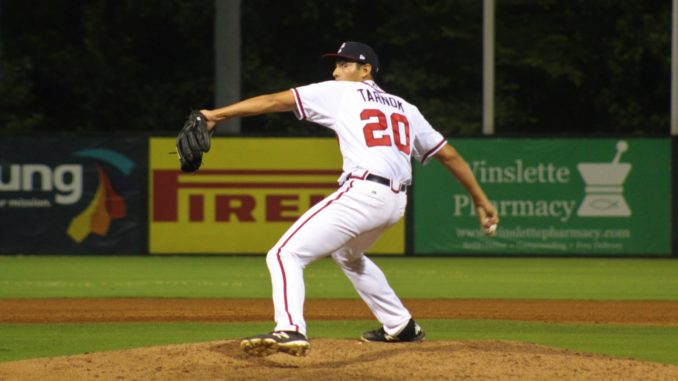
19. Freddy Tarnok, RHP
Age: 20 | Throws: R
3.96 ERA | 4.03 FIP | 27 G, 11 GS | 77.1 IP | 4.77 BB/9 | 9.66 K/9
Current Assignment: A Rome
Acquired: Drafted, 3rd Round – 2017
Prior Season Ranking : 25
It was a tale of two seasons for Tarnok, the sole teenage pitching prospect on Rome’s roster in 2018. To control his innings, Tarnok pitched out of the bullpen in the first half and excelled. In 16 relief appearances from April through June, Tarnok pitched to a sterling 1.26 ERA and struck out over 12 batters per nine innings, earning a spot on a SAL All-Star team.
The Braves inserted Tarnok into the rotation starting in July, and the results weren’t quite so shiny. Tarnok pitched to a 6.26 ERA as a starter, despite cutting his walk rate almost in half. This was due to allowing harder contact, which increased his opponent’s production on balls in play.
So what happened? The answer is a difference in his development emphasis between the two roles. As a reliever, Tarnok was simply putting in the work, refining his mechanics and working his fastball and curveball, which were plenty effective in short stints. As a starter, Tarnok was working more on control and working on his third pitch, a developing change-up. His strikeout rate lowered and that plus poorer luck on balls in play contributed to his unsightly ERA as a starter. However this is a case where the stats just don’t really tell the whole story. Tarnok had an exceptional year of development, and the quality of his work improved steadily despite the game outcomes. By the end of the season his change-up was showing good movement and depth and he was generating more swing-and-miss with a tighter curveball. The production caught up in his final three starts, pitching to a 1.35 ERA in 13.1 innings.
Tarnok will turn 20 this winter and he shouldn’t have an innings restriction on him. He will likely start the season in the Florida rotation. Like Touki Toussaint before him, Tarnok didn’t start pitching until late in his high school career, so he may be a slower burn through the organization than fans have gotten used to with some other prospects, but he’s coachable and talented, which is a good combination and he’s in an organization that can afford to be patient with him. -AH

18. Huascar Ynoa, RHP
Age: 20 | Throws: R
4.56 ERA | 3.69 FIP | 24 G, 24 GS | 116.1 IP | 4.18 BB/9 | 10.13 K/9 (A, A+)
Current Assignment: A+ Florida
Acquired: Trade w/Minnesota Twins – 2017
Prior Season Ranking: 35
Ynoa showed across-the-board improvement in his first full season of pro ball, while advancing two levels. Like Tarnok, a somewhat inflated ERA masks that progress to some extent.
Pitching the entire season as a starter, Ynoa nevertheless saw an uptick in the quality of his “stuff”, including a fastball that went from sitting in the low ’90s in rookie ball to the mid-90s in 2018, occasionally touching 100 mph. This in turn helped the separation with his developing change-up, which is becoming a true strikeout weapon. Ynoa also has a decent slider that occasionally shows to be above average.
Ynoa could advance quickly if the Braves elect to move him to a relief role, but he has shown enough improvement to rate a continued run as a starter. The Braves were convinced enough that a rebuilding team could poach him in the Rule V draft that they added him to the 40-man roster this week, but I would not expect to see him in Atlanta in 2019; instead he will likely return to advanced-A Florida for continued fine-tuning. -AH

17. Tristan Beck, RHP
Age: 22 | Throws: R
0.00 ERA | 1.95 FIP | 3 G, 1 GS | 4.2 IP | 3.86 BB/9 | 13.50 K/9
Current Assignment: Rk GCL
Acquired: Drafted, 4th Round – 2018
Prior Season Ranking: N/A
Beck was highly scouted out of high school, but he ended up going to Stanford. While no doubt he values the time spent at the prestigious university and the friends and the experiences that will stay with him for a lifetime, in the short term it likely cost him several million dollars. Surgery to repair a stress fracture in his back cost him his 2017 season, and returning his junior season found him understandably rusty. This is how Beck found himself falling to the 4th round to the Atlanta Braves.
When healthy, Beck has four pitches that rate above average (fastball, slider, curveball, change-up) and an advanced feel for pitching. Health will continue to be the primary question about Beck until he shows it’s no longer an issue, but if he can manage a full season of work, no prospect anywhere on this list is likely to move quicker than him. Reports out of the instructional leagues were very positive. Beck could start the season as high as Mississippi, but with a slew of other prospects ahead of him and no hurry to bring him along, he’s more likely to start in Rome or Florida. -AH
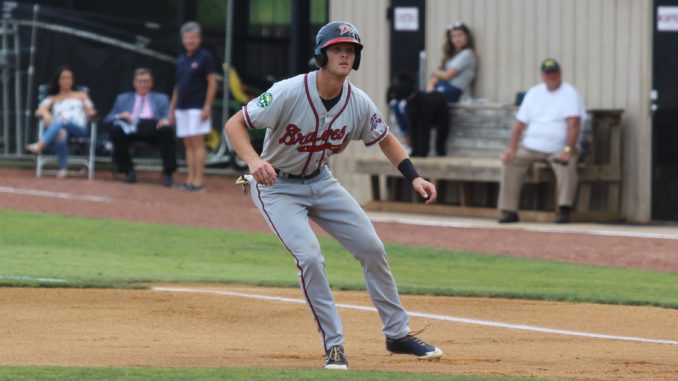
16. C.J. Alexander, 3B
Age: 22 | Bats: L
.352/.429/.495 | 157 wRC+ | 2 HR | 1 SB | 11.9% BB | 18.6% K (Rk, Rk+, A+)
Current Assignment: A+ Florida
Acquired: Drafted, 20th Round – 2018
Prior Season Ranking: N/A
Beck may end up being a steal in the 4th round in 2018, but the Braves selection and signing of Alexander in the 20th round stands as perhaps the biggest coup of all. Alexander has taken to pro ball like a duck to water, hitting his way from the GCL up to advanced-A Florida in the space of ten weeks. That slash line above isn’t just a product of hitting against rookie ball competition: he hit .325/.386/.450 in 21 games for the Fire Frogs, in a league known to suppress offense.
Alexander is listed at 6′-5″ and 215 pounds but looks like he still could fill out the frame some more. He demonstrates good strike zone judgement and pitch recognition, with a bat that goes straight to the ball and hits to all fields with authority. Coming out of college, his raw power was considered his carrying tool, but at least so far that’s manifested in more hard line drives than over-the-fence pop. Defensively he shows average range and a good arm, and he should be able to stick at third base if he doesn’t grow out of the position.
It won’t take much of an adjustment to have more of those line drives go over the fence, so there is room for more production even if he’s unlikely to hit enough for +.420 OBPs. He could start the season back in Florida since he only got a taste of that level, but a good spring could land him in Mississippi. -AH
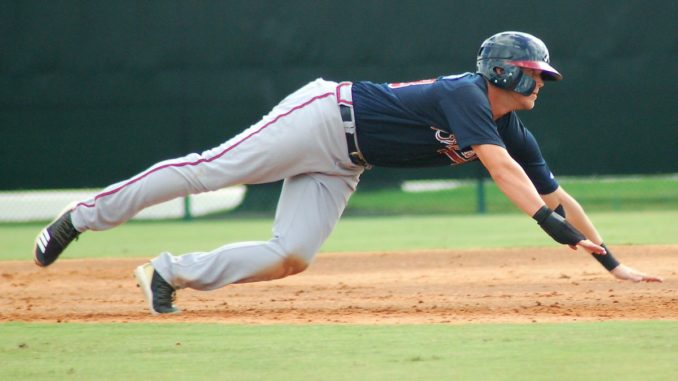
15. Greyson Jenista, OF
Age: 22 | Bats: L
.265/.328/.395 | 102 wRC+ | 4 HR | 4 SB | 9.2% BB | 16.3% K (Rk+, A, A+)
Current Assignment: A+ Florida
Acquired: Drafted, 2nd Round – 2018
Prior Season Ranking: N/A
Jenista represents the highest drafted collegiate position player taken by the Braves since selecting infielder Richard Lewis out of Georgia Tech in 2001 and will hopefully prove to be a better selection. Jenista rose up three levels in his half season as a pro, finally stumbling down the stretch with advanced-A Florida (.152/.230/.227 in 19 games).
Along the way Jenista showed good bat speed and strong wrists, enough to line shots to all fields against lower level pitching competition. A large fellow at 6′-4″ and 210 pounds, Jenista’s approach and bat plane limit his over-the-fence potential despite his overall raw power. As he advanced, pitchers took advantage of Jenista’s tendency to get out on his front foot and either swing through or tap breaking balls weakly to the infield. While Jenista mostly played first base in college, the Braves put him almost exclusively in right field and he showed solid range and a good arm for the position. Despite his size, Jenista is athletic and is a good baserunner.
Jenista’s performance in his first taste of pro ball matched his college scouting, and the Braves clearly believe his issues are fixable. Like with Alexander, just a few adjustments at the plate could have Jenista providing middle-of-the-order production in the big leagues. -AH
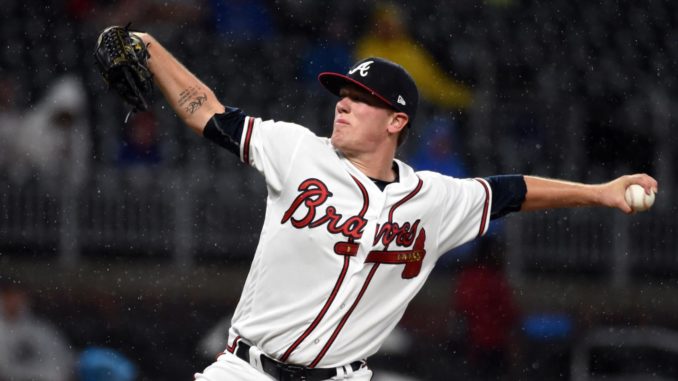
14. Kolby Allard, LHP
Age: 21 | Throws: L
2.72 ERA | 3.40 FIP | 19 G, 19 GS | 112.1 IP | 2.72 BB/9 | 7.13 K/9
Current Assignment: AAA Gwinnett
Acquired: Drafted, 1st Round – 2015
Prior Year Ranking: 5
Kolby Allard started the 2018 season at AAA Gwinnett after spending the entire 2017 campaign at AA Mississippi, where he had a successful 27-start season, primarily at the age of 19, alongside Mike Soroka. He pitched impressively and consistently throughout the season for Gwinnett, going fifteen starts before allowing more than three earned runs in an outing. Allard earned a promotion to Atlanta and made his first major league start on July 31, where he toughed out five innings against the Marlins in terrible weather to earn his first MLB win. He made just two relief appearances over the next three weeks where things didn’t go as well before being optioned to Gwinnett. Allard made one brief start there before being called back up to finish the season in Atlanta, although he wasn’t used again. The circumstances behind Allard’s final recall are interesting, as it happened one day before the Braves would have used up his option for the season. The Braves saved the option while essentially putting Allard in storage on the expanded September roster for the remainder of the season. Allard was rewarded for his efforts on the season with the Gwinnett Stripers Pitcher of the Year award.
Kolby Allard improved his batting average against and WHIP while maintaining his already-low walk rate, but as it has at every level since rookie ball, his strikeout rate decreased to a career-low 7.1 per nine innings. With his fastball velocity topping out in the 89-90 range, Allard needs to work on how better to locate his arsenal to get the best results. He did manage to reduce his home runs allowed from eleven in 150 innings at Mississippi to six in 112.1 innings at Gwinnett, no small feat since Coolray Field is much more conducive to homers than Trustmark Park. There simply isn’t room for Allard in the big-league rotation to start 2019, so he will either begin at Gwinnett again or be included in a trade this offseason. -MC
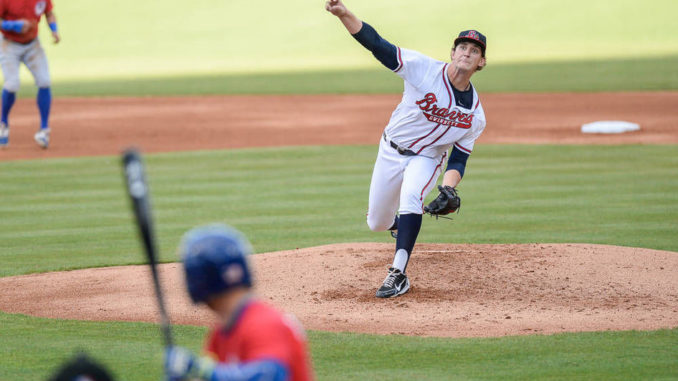
13. Patrick Weigel, RHP
Age: 24 | Throws: R
0.00 ERA | 0.66 FIP | 4 G, 3 GS | 4.0 IP | 0.00 BB/9 | 13.50 K/9
Current Assignment: AAA Gwinnett
Acquired: Drafted, 7th Round – 2015
Prior Year Ranking: 15
Patrick Weigel, who was the 2016 Braves’ minor league pitcher of the year, could be a surprise to some in being ranked this high on this list after missing almost the entire 2018 season following Tommy John surgery in June of 2017. The fact is, Weigel was VERY close to a major-league call-up before injuring his elbow, Sean Newcomb had just been brought to Atlanta and Weigel was the next man up.
Weigel did put in some time with the GCL Braves in August, making four one-inning appearances over a fifteen-day period. He only allowed two hits while striking out six with no walks while, most importantly, coming out of this stretch healthy.
Patrick Weigel’s landing point at the start of 2019 and his role are tough to determine. From a competitive standpoint, Mississippi is his most likely landing spot due to not pitching versus significant competition for nearly two years at that point. Once he gets up to speed, he can move up to Gwinnett to face competition more appropriate to his level. Also to be determined, will Weigel be used as a starter or a reliever? He could either be broken back in as a reliever or on a pitch count as a starter until he builds his endurance back up to his previous norm. -MC
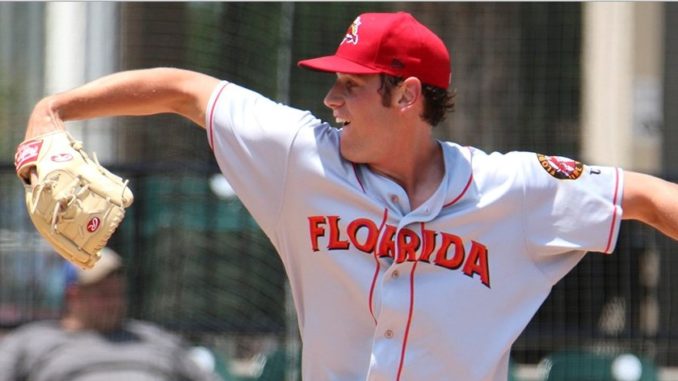
12. Joey Wentz, LHP
Age: 21 | Throws: L
2.28 ERA | 3.64 FIP | 16 G, 16 GS | 67.0 IP | 3.22 BB/9 | 7.12 K/9
Current Assignment: A+ Florida
Acquired: Drafted, 1st Round – 2016 (pick acquired from Los Angeles Dodgers)
Prior Year Ranking: 12
Joey Wentz spent the entire 2017 campaign at Rome and made the natural progression to Florida for 2018. Wentz’s 2018 season can be divided into several sections: the first part of his season was a seven start stretch where he started off strong in giving up just one run in his first three starts covering fourteen innings. The next four starts didn’t go as well, culminating in a horrific start on May 11 where he walked six and gave up five runs in 1.2 innings. An oblique injury would lead for that to be Wentz’s final start for a month. Wentz would return on June 13 and, in a stretch from June 21 to July 14, he pitched five consecutive scoreless starts with a 0.69 WHIP covering 29 innings. Following this stretch, he left after two innings in his next start on July 19 with a second oblique injury and that would be his last start until August 27. Wentz made two brief starts on pitch counts to close out the season.
Joey Wentz only pitched 67 innings in 2018 with his health issues, causing his progress to fall behind that of rotation-mates Ian Anderson and Kyle Muller. The 2019 season could start with Wentz starting off at Florida to get his feet wet before moving up to Mississippi or, if the Braves brass feels comfortable, could just move him up to Mississippi right off the bat to rejoin Anderson and Muller. At 21 years of age, though, there’s no pressure to move Wentz along too quickly. -MC
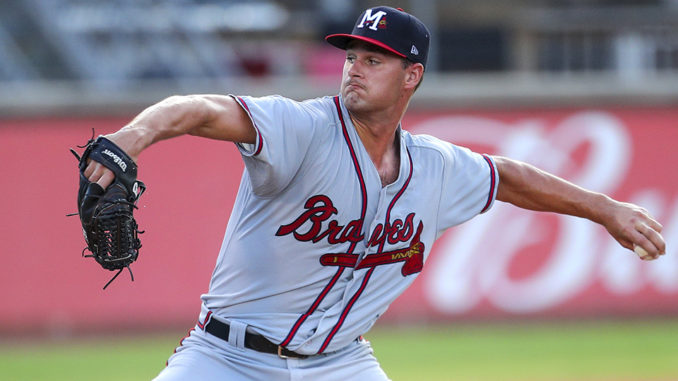
11. Kyle Muller, LHP
Age: 21 | Throws: L
3.03 ERA | 3.45 FIP | 25 G, 25 GS | 139.2 IP | 2.96 BB/9 | 8.31 K/9
Current Assignment: AA Mississippi
Acquired: Drafted, 2nd Round – 2016
Prior Year Ranking: 19
Kyle Muller started off the 2018 season at Rome after spending 2017 at Danville, where he pitched 47.2 innings over 11 starts in his age-19 season. Unlike in years past, where the Braves would keep prospects in Rome for a full season, Muller was promoted to Florida in early May after six starts where he allowed just a 2.40 ERA and a 1.07 WHIP over 30 innings. At Florida, Muller encountered control issues, walking nearly five per nine innings over his first eight starts at the level. In his final six High-A starts, though, he walked just 2.2 per nine. Muller also built up his endurance in going at least six innings in seven of his last eight Florida starts.
Like a number of other highly-touted prospects, Muller earned an early-August promotion to AA Mississippi, where he made five starts to close out the season. He jumped right in with a 3.10 ERA and 0.966 WHIP and only allowed as many as four earned runs in one start. The highlights of Muller’s Mississippi tenure were a start on August 11 where he struck out ten in 5.2 innings and his next start on August 18 where he tossed seven shutout innings.
Kyle Muller, along with Ian Anderson, are at the forefront of the next wave of elite starting pitching working its way to Atlanta. Muller finished the season with 139.2 innings over three levels, nearly triple his workload from 2017. He followed up by pitching well in the Arizona Fall League, earning a berth in the Fall Stars Game. 2019 should see Muller returning to Mississippi to start off the season, but could move up to Gwinnett depending on his performance and clearing the logjam of starting pitching that will most likely exist at AAA. -MC

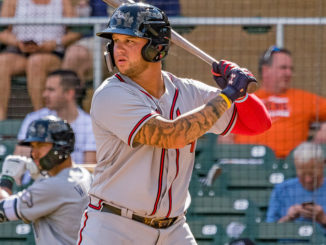
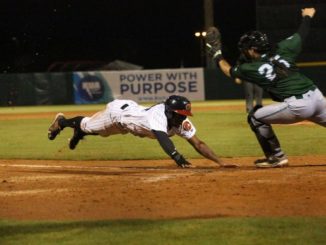

Leave a Reply